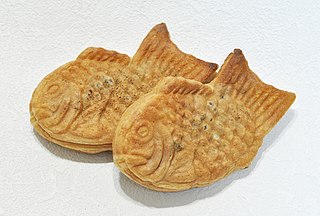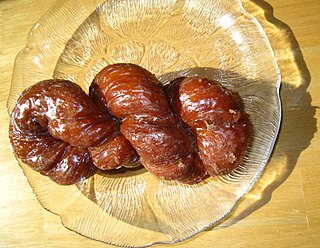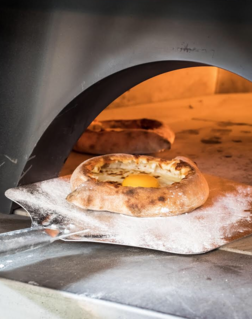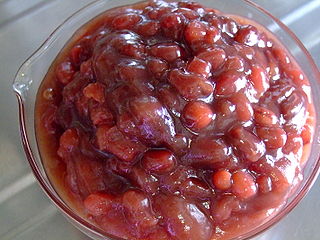
Pastry is a dough of flour, water and shortening that may be savoury or sweetened. Sweetened pastries are often described as bakers' confectionery. The word "pastries" suggests many kinds of baked products made from ingredients such as flour, sugar, milk, butter, shortening, baking powder, and eggs. Small tarts and other sweet baked products are called pastries. Common pastry dishes include pies, tarts, quiches, croissants, and pasties.

Taiyaki is a Japanese fish-shaped cake, commonly sold as street food. It imitates the shape of tai, which it is named after. The most common filling is red bean paste that is made from sweetened azuki beans. Other common fillings may be custard, chocolate, cheese, or sweet potato. Some shops even sell taiyaki with okonomiyaki, gyoza filling, or a sausage inside. Smaller, differently shaped versions called kingyoyaki are also available and often sold in bags of five, ten, or more.

Pirozhki are Russian and Ukrainian baked or fried yeast-leavened boat-shaped buns with a variety of fillings. Pirozhki are a popular street food and comfort food in Russia and a stereotypical part of Russian culture.

A samosa is a fried or baked pastry with a savory filling, such as spiced potatoes, onions, peas, cheese, beef and other meats, or lentils. It may take different forms, including triangular, cone, or half-moon shapes, depending on the region. The Indian style, often accompanied by a chutney, is probably the most widely known of a broad family of recipes from Africa to China, which have origins in medieval times or earlier. Samosas are a popular entrée, appetizer, or snack in the local cuisines of South Asia, Western Asia, Southeast Asia, the Mediterranean, and Africa. Due to emigration and cultural diffusion from these areas, samosas today are often prepared in other regions.

A cruller is a deep-fried pastry popular in the US and Canada often made from a rectangle of dough, with a cut made in the middle that allows it to be pulled over and through itself producing twists in the sides of the pastry. Crullers have been described as resembling "a small, braided torpedo". Some other cruller styles are made of a denser dough somewhat like that of a cake doughnut formed in a small loaf or stick shape, but not always twisted. Crullers may be topped with plain powdered sugar; powdered sugar mixed with cinnamon; or icing.

Kuih are bite-sized snack or dessert foods commonly found in Southeast Asia. It is a fairly broad term which may include items that would be called cakes, cookies, dumplings, pudding, biscuits, or pastries in English and are usually made from rice or glutinous rice. The term kuih is widely used in Malaysia, Brunei, and Singapore, and kueh or kue is used in Indonesia, to refer to sweet or savoury desserts. Though called by other names, one is likely to find various similar versions of kuih in neighbouring countries, such as Vietnam, Thailand, and Myanmar. For example, the colourful steamed kue lapis and the rich kuih bingka ubi are also available in Myanmar, Thailand, and Vietnam. In the Philippines, kuih are referred to in Tagalog as kakanin.

Khachapuri is a traditional Georgian dish of cheese-filled bread. The bread is leavened and allowed to rise and is shaped in various ways, usually with cheese in the middle and a crust which is ripped off and used to dip in the cheese. The filling contains cheese, eggs and other ingredients.

Pastel de nata ([pɐʃˈtɛɫ dɨ ˈnatɐ] is a Portuguese egg custard tart pastry dusted with cinnamon. Outside Portugal, they are particularly popular in other parts of Western Europe, Asia and former Portuguese colonies, such as Brazil and Macau. The Macanese pastel de nata was also adopted by KFC and is available in regions such as mainland China and Taiwan. In Indonesia, this pastry is especially popular in Kampung Tugu, Jakarta, a culturally Portuguese enclave.

Kue is an Indonesian bite-sized snack or dessert food. Kue is a fairly broad term in Indonesian to describe a wide variety of snacks; cakes, cookies, fritters, pies, scones, and patisserie. Kue are made from a variety of ingredients in various forms, some are steamed, fried or baked. Kue are popular snacks in Indonesia, which has the largest variety of kue. Because of the countries' historical colonial ties, Koeé (kue) is also popular in the Netherlands.

Bungeo-ppang is a fish-shaped pastry stuffed with sweetened red bean paste. One of South Korea's most popular winter street foods, the snack is often sold at street stalls, grilled on an appliance similar to a waffle iron but with a fish-shaped mold. Red bean paste is the standard filling but many bungeo-ppang sold as street food are filled with pastry cream, pizza toppings, chocolate and others.
Pastel is the Spanish and Portuguese word for pastry and is the name given to different typical dishes of many countries that speak or spoke those languages.

Baklava is a layered pastry dessert made of filo pastry, filled with chopped nuts, and sweetened with syrup or honey. It was one of the most popular sweet pastries of Ottoman cuisine.

Chebureki is a deep-fried turnover with a filling of ground or minced meat and onions. It is made with a single round piece of dough folded over the filling in a crescent shape.

A palmier, pig's ear, palm heart, or elephant ear is a French pastry in a palm leaf shape or a butterfly shape, sometimes called palm leaves, cœur de France, French hearts, shoe-soles, or glasses that was invented in the beginning of the 20th century.

Pan dulce is the name for a variety of Hispanic pastries. The creation of sweet bread was influenced by European immigrants living in Mexico like the French, Spanish, and Italians who introduced baked goods such as crispy rolls, baguettes, and sweet pastries to Central America and Mexico. This inspired the indigenous peoples to create different types of panes dulces such as besos, conchas, and cuernos, among others. They are considered to be one of Latin America's most inexpensive treats and are consumed daily as breakfast or late supper, known as merienda.

Red bean paste or red bean jam, also called adzuki bean paste or anko, is a paste made of red beans, used in East Asian cuisine. The paste is prepared by boiling the beans, then mashing or grinding them. At this stage, the paste can be sweetened or left as it is. The color of the paste is usually dark red, which comes from the husk of the beans. In Korean cuisine, the azuki beans can also be husked prior to cooking, resulting in a white paste. It is also possible to remove the husk by sieving after cooking, but before sweetening, resulting in a red paste that is smoother and more homogeneous.















